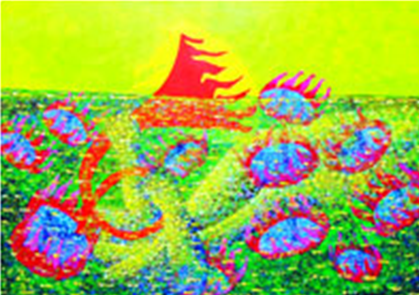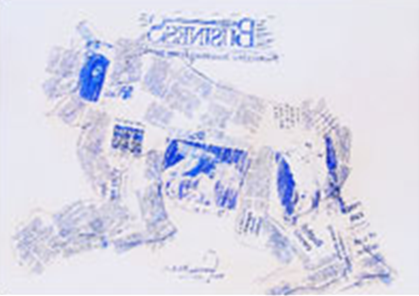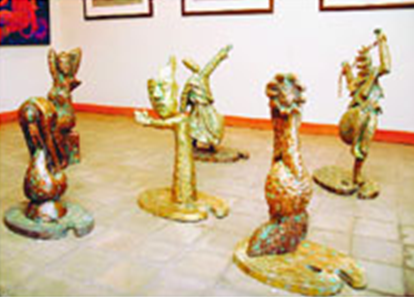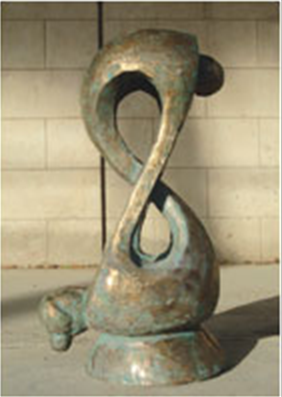Shahid Rassam
This is a collection of articles archived for the excellence of their content. Readers will be able to edit existing articles and post new articles directly |
Shahid Rassam
he Ideal & The Material
If Shahid Rassam’s intention is to agitate the onlooker with his overloaded canvases in order to provoke instant reaction to his narrative then he has been successful. The works are as physically disturbing as the stories he is purporting, writes Salwat Ali
Artist Shahid Rassam’s recent cache of sunflower paintings on show at Canvas Gallery, Karachi seemed to close in on the viewer, so intense was the heat of the colours blazing off the walls. But Rassam’s leitmotif, the ubiquitous sunflower, aflame with lashings of red and yellow, speaks a sorry tale.
Instead of the beaming bloom in all its glory he alludes to the flower’s sunset wilt and droop. Referencing to it as a symbol of despair and doom Rassam has painted gory scenes of human distress.
As a significant floral species, the sunflower enjoys a cultural and religious presence. It is considered the lord of the day. It is esteemed by the sun-worshippers of Peru; it reflects devout feelings for it turns its visage ever toward the sun bowing humbly at sunset. In Christianity it is linked to God’s love; it represents prayer and monastic obedience. In China it is a magical flower and represents longevity.
Aesthetically the sunflower’s emotive characteristics were fist highlighted to advantage in Vincent van Gogh’s sunflower paintings opening the door to its modernistic evolution in art. Not only did van Gogh inspire others to paint sunflowers, but he also created a trend that would span various lifestyles and personas.
Van Gogh’s infamous sunflowers altered many views on colour schemes, exaggerated features, and floral portrayals in minimalist form.
The famed Mexican artist Diego Rivera was strongly influenced by Vincent van Gogh, but also portrayed his personal political message in his art. His paintings are social commentaries of his times and involve turbulent expressions of anti-establishment views.
For Rassam, the earliest relevance to the floral form was as an emblem of injustice to womankind. Attacking issues of gender oppression only his earlier works portrayed the woman in chains and as a pawn, hocked and wagered as a commodity. The latter half of the current exhibition consisting of monochrome drawings on newsprint (the business and economic pages) is still devoted to this exploitative attitude of society but otherwise the critical thrust this time is on current affairs.
Taking pot-shots at the socio-political scenario, he has vented his feelings about the present wave of terror and extremism. The menacing bull image is depicted wearing a cleric’s cap alluding to fundamentalist rage and the victims, women and children are painted as the helpless beings that bear the brunt of these atrocities.
The ongoing religo-political and social strife, within and without is grist to the mill of most new art these days and Rassam’s aesthetics identify with this trend. But brainstorming themes and ideas is only part of the composite process of creating a painting. Physical execution of those ideas is the crucial next step. Technically the art on show is loud and not just chromatically. Too many elements vying for viewer attention simultaneously jars the senses — alongwith colour it is Rassams compositional ploys, textural treatments and figurative distortions that hit the eye with full strength.
Attempting to establish conflict between the ideal and the material, he has divided his canvas into two, where an area of relative calm is juxtaposed with a nether world of struggle and aggression. As the eye and mind tried to dwell on the figurative nuances it is immediately distracted by the artist’s abrasive and emphatic textural imprints and all the while the strong primary hues continued to assert their presence.
If the intention of the artist is to agitate the onlooker with his overloaded canvases in order to provoke instant reaction to his narrative then he has been successful. The works are as physically disturbing as the stories he is purporting.
This exhibition also introduces Rassam as a sculptor. Rough, rudimentary figurative pieces sculpted in the hard to chisel gun metal with textured surfaces similar to the harsh, crude markings on his canvases relate to the ethos of the show. The remains of a suicide bomber head held high for public display was a noticeable piece — it gained impact when you realised that his lips were sewn and sealed.
As an artist Rassam is still evolving. He is experimenting with concept, technique, treatment and application of paint but has yet to harmonise his activities into a resolved whole. He is denying himself the positive effects of negative/empty space. His preference for bold chromatics is laudable but there is anarchy afoot in his colour palette — a wee bit of control in every direction can settle the clutter and ease the viewing experience.
On the cover: Whirling dervish, 2008, bronz, 36 inches
Top: Untitled, 2007
Above: Mother and child, 2006
Left: Untitled, 2007, charcoal on newsprint
Top left: Captive, Raqsay Zanjeer and other statues
Shahid Rassam
Storytelling in Technicolour
By Aziz Kurtha
Shahid Rassam is clearly a serious painter and sculptor who deserved to win a scholarship of the British Council in 1999 to study for two years in St. Martins School of Art; one of the best institutes in the U.K. However his works do not always do justice to his talents and substantial knowledge of Urdu literature and poetry.
The exhibition at the Bagash Gallery in Dubai titled 'Worshippers and Sinners' was a fair representation of the themes that occupy Shahid's mind including, in particular, the use of the sunflower image to symbolize the faces of women and the chain bound hands showing the restrictions on humans despite the appearance of freedom.
His imagery certainly catches the eye because he uses psychedelic pigments of bright yellow, orange, leaf greens etc. and there is a common thread in most of his works whether on board or canvas, with a sort of line dividing the upper one-third of the canvas from the bottom half and normally separated by a wide border of orange, blue or green. He explains that he is particularly concerned about the plight of women in Pakistan who are not allowed to play a significant role in society and indeed have many false accusations thrown at them, over and above the daily grind of laborious domesticity.
He was originally very taken up with the lives of ballet and other dancers particularly as they had a very short professional life, and sometimes ended up in red light areas. From there he developed an interest in classical dance and poetry which engages him very deeply and forms the basis of his very striking sculpture 'Dance in Chains' made from gun metal; a medium which is extremely difficult to make malleable. As luck would have it this particular sculpture was held up at customs in Karachi where the authorities thought it was a statue of Buddha and thus refused to allow it to be taken out of the country!
Shahid is a very promising artist and a number of critics including artist Tassaduq Sohail have reviewed his work favourably. Describing Shahid's work, Sohail said, "He gathers hundreds of stories in a painting and says a great deal about the status of women in society".
However if Shahid is to progress further, for which he certainly has the ability, he needs to have a broader range of themes, a more varied and muted use of colour and relax the all too frequent use of the sunflower image.








